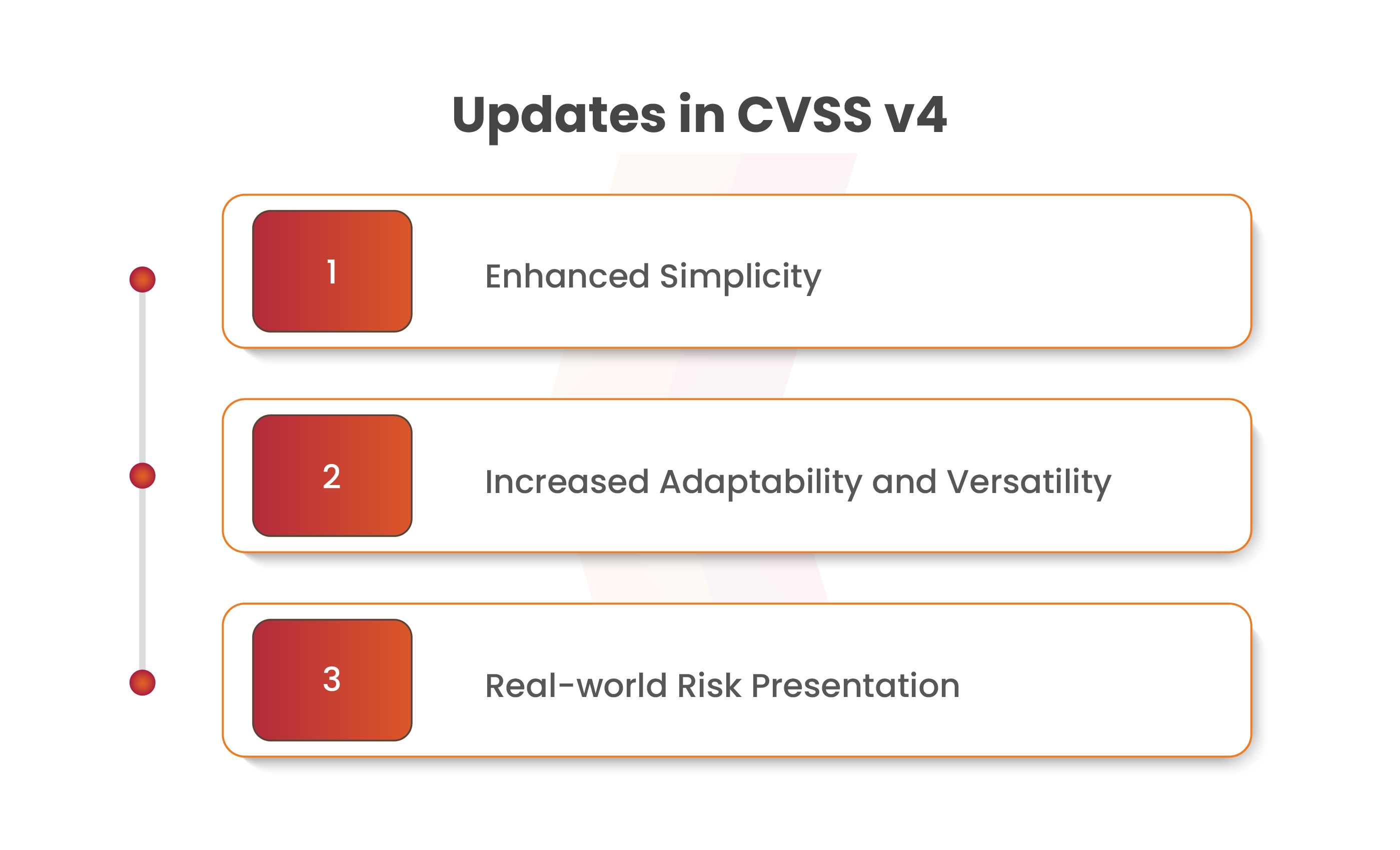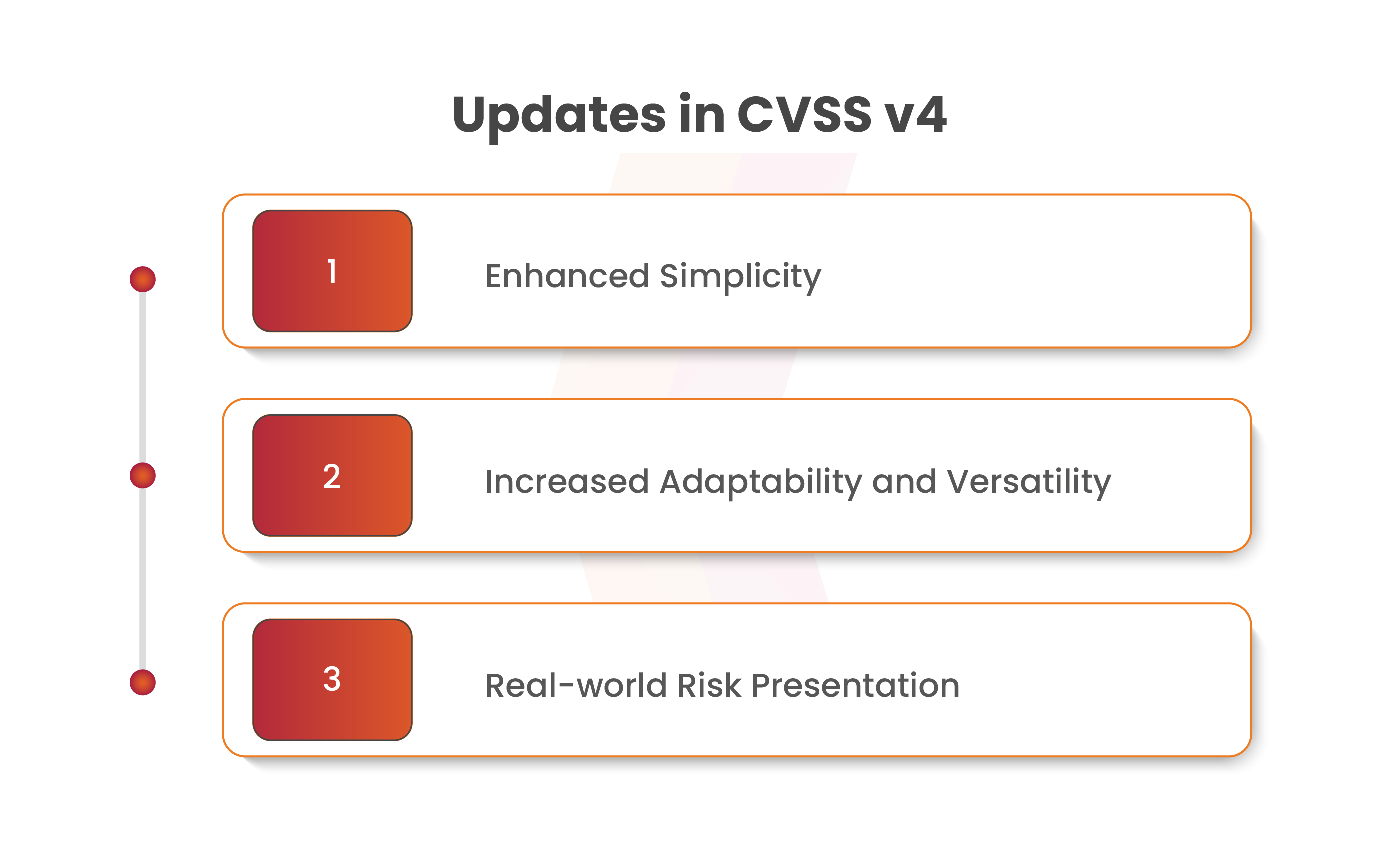
2023-11-21 13:56:36 Author: securityboulevard.com(查看原文) 阅读量:25 收藏
Specialists utilize the Common Vulnerability Scoring System (CVSS) as a critical foundation for assessing and ranking cybersecurity vulnerabilities. When it comes to the methodology used to determine the severity of vulnerabilities, version 4 is a significant advancement over version 3. Organizations can strengthen their defenses and more effectively minimize risks by being aware of the distinctions between these versions. CVSS has been pivotal in this arena, evolving to refine the assessment process. Central to this evolution is the iterations of Common Vulnerability Scoring System, particularly the transition from version 3 to version 4. Understanding the differences between these iterations is akin to deciphering the refined nuances that define modern vulnerability assessment methodologies. Now let’s examine the differences between the two.
Features of CVSS v3 and v4
The Common Vulnerability Scoring System has evolved through different versions, primarily CVSS v3 and v4, each introducing unique features. Let’s discuss in more detail:
Metrics Structure
CVSS v3:
Introduced as an enhancement over previous versions, it brought in a structured framework consisting of three main metric groups: Base, Temporal, and Environmental. This structure aimed for a holistic view of vulnerabilities: intrinsic (Base metrics), changes over time (Temporal metrics), and adaptability to various environments (Environmental metrics).
CVSS v4:
Building upon the foundation of its predecessor, it carries forward the Base, Temporal, and Environmental metrics but refines the approach. It streamlines the assessment process by focusing on a reduced set of metrics while expanding coverage to accommodate various types of vulnerabilities.
Scope and Impact:
CVSS v3:
The third version primarily defined the scope in terms of the impact that a vulnerability might have on the impacted component. The Base metrics evaluated the impact on confidentiality, integrity, and availability, providing a comprehensive overview of the potential risks associated with a vulnerability.
CVSS v4:
In contrast, it broadens the scope, precisely a more comprehensive range of vulnerabilities. It emphasizes the impact on different layers within complex systems and delves deeper into potential impacts on privileges, users, and components, offering a more holistic assessment of the threat landscape.
Complexity and Exploitability
CVSS v3:
This iteration evaluated the complexity and exploitability of a vulnerability as separate entities. It scrutinized the specific conditions required for exploitation and the level of expertise necessary to exploit the vulnerability.
CVSS v4:
In a refinement of the assessment process, it amalgamates these elements into a single metric known as the Attack Vector. This streamlined approach provides a more holistic assessment of the vulnerability’s exploitability, considering both complexity and potential attack vectors in a more unified manner.
Scoring System for vulnerabilities:
CVSS v3:
The scoring system in v3 ranged from 0.0 to 10.0, where a higher score indicated a more severe vulnerability. The Base score provided an initial assessment, which could be further adjusted using Temporal and Environmental metrics to adapt to specific environments.
CVSS v4:
Retaining the same scoring range enhances accuracy by addressing certain scoring inconsistencies and refining the scoring formula. This ensures a more precise and consistent assessment of vulnerabilities across different environments and technologies.
Book a Free Consultation with our Cyber Security Experts

What is Changed in CVSS v4?
CVSS v3 was criticized for complexity and lack of clarity; CVSS v4 aims to resolve these issues by potentially adding complexity but removing criticized elements.
Below are the updates in CVSS v4.0:
Enhanced Simplicity
Common Vulnerability Scoring System v4 aims to streamline scoring, removing ambiguity through clearer metric guidance and definitions. This version refines concepts like “Attack Complexity” and “Attack Requirements” for a more transparent scoring process, aiding precise vulnerability assessment and ensuring consistency across organizations.
Increased Adaptability and Versatility
CVSS v4.0 introduces new metrics and a modular structure, allowing organizations to customize the scoring system to their specific needs. It uses new metrics for operational tech and safety, differentiating between active and passive user interaction for better vulnerability assessment. This enhanced flexibility enables a more accurate risk representation for individual organizations.
Real-World Risk Presentation:
CVSS v4.0 offers a more comprehensive representation of a vulnerability’s true risk. It incorporates extra elements like the likelihood of exploitation and the potential impact of a successful attack. This version emphasizes threat intel and environmental metrics for a more precise risk assessment. The introduction of fresh concepts such as “Automatable,” “Recovery,” and “Mitigation Effort” brings added depth to understanding each vulnerability.

Why does the transition to CVSS v4 matter?
The change from CVSS v3 to v4 represents more than just a version number increase; it represents a significant advancement in vulnerability assessment techniques. This development is like improving a crude drawing to a very precise design in the cybersecurity domain. Expanding metrics in CVSS v4 marks substantial progress, aligning the model better with modern threat complexities.
Refined Metrics for Comprehensive Evaluation
Common Vulnerability Scoring System v4 brings a refined set of metrics that speak to the intricate nuances of modern vulnerabilities. Streamlining and optimizing the assessment criteria, enables a more granular evaluation, considering diverse factors that impact the severity and exploitability of vulnerabilities. This approach acknowledges the interplay between various elements within complex systems, offering security professionals a more detailed and accurate portrayal of potential risks.
Embracing the Expanded Scope:
The change from CVSS v3 to v4 represents more than just a version number increase; it represents a significant advancement in vulnerability assessment techniques. This development is like improving a crude drawing to a very precise design in the cybersecurity domain. Expanding metrics in the latest version is a big step, aligning the model with modern threat complexities.
Framework for Effective Prioritization:
The transition to the new version equips security professionals with a more precise and adaptable framework, essential for effective prioritization and mitigation strategies. Its improved metrics and wider scope depict vulnerabilities more accurately across various tech environments, showing their severity and potential impact better. This precision empowers security teams to prioritize vulnerabilities more effectively, allocating resources where they are most urgently needed and proactively mitigating risks.
Conclusion
Moving from CVSS v3 to v4 is like upgrading from a simple drawing to a detailed map. CVSS v4’s changes mark a significant stride in grasping vulnerabilities amid today’s complex cyber environment. For security professionals and companies, these improvements offer a clearer assessment of vulnerability severity in the digital landscape. It digs deep into different factors that make problems worse, helping VAPT services (Vulnerability Assessment and Penetration Testing) do their job better. This smarter system sees how different parts of a complicated setup affect each other, making risk assessments more accurate.
The latest version offers broader perspectives, improved measurements, and adaptable setups to prioritize issues in risk assessments. It’s like having a guide that points out where the most urgent problems are, allowing them to focus their efforts where the risks are highest. This means they can prioritize and manage risks more effectively, strengthening their overall security posture.
Kratikal, a CERT-In empanelled auditor, delivers comprehensive cybersecurity solutions aimed at protecting businesses from a spectrum of cyber threats, focusing notably on protecting web applications against potential risks. Collaboration with Kratikal empowers businesses to take proactive measures in detecting and resolving security vulnerabilities, thereby thwarting malicious hackers from exploiting these weaknesses.

The post In What ways do CVSS v3 and CVSS v4 differ? appeared first on Kratikal Blogs.
*** This is a Security Bloggers Network syndicated blog from Kratikal Blogs authored by Shikha Dhingra. Read the original post at: https://kratikal.com/blog/in-what-ways-do-cvss-v3-and-cvss-v4-differ/
如有侵权请联系:admin#unsafe.sh
